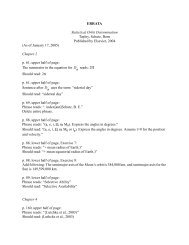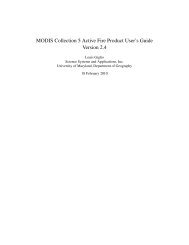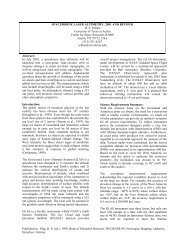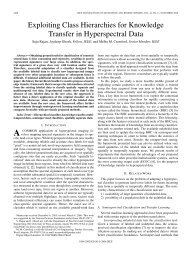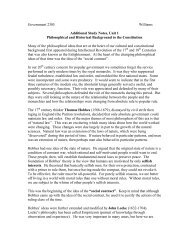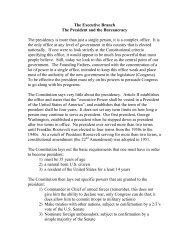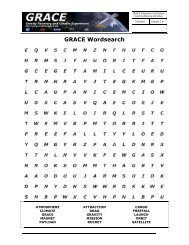(GLAS) PRECISION ATTITUDE DETERMINATION - Center for ...
(GLAS) PRECISION ATTITUDE DETERMINATION - Center for ...
(GLAS) PRECISION ATTITUDE DETERMINATION - Center for ...
Create successful ePaper yourself
Turn your PDF publications into a flip-book with our unique Google optimized e-Paper software.
The B-matrix is very important since it contains all the in<strong>for</strong>mation from the measurementand reference vectors. The construction of this matrix is the beginning of every solutionof the Wahba Problem in this section. Finally, the original Wahba Problem proposed inEquation 2.20 turns into the minimization problem o<strong>for</strong> the maximization problem ofJ(A) =1; tr(AB T ) (5.5)J 0 (A) =tr(AB T ): (5.6)There exist many SFAD algorithms. The simple description of these methods are given inthe following sections, while the precise derivations of these can be found in the references.QUESTThe QUEST algorithm is an improved version of the q-method developed by Davenport[52]. He has shown that the minimization of the loss function J(A) can be trans<strong>for</strong>medinto an eigenvalue problem of a 4 4 matrix, K :whereK ="S ; IZ~TS = B T + B~Z =nXi=1 = trB:~ Z#: (5.7)a i ^Wi ^V i (5.8)It was shown that components of the eigenvector corresponding to the biggest eigenvaluein K matrix are the attitude quaternions. Shuster's QUEST algorithm [39] is a variation ofthe q-method in the last step of q-method. It avoids the necessity <strong>for</strong> solving the eigenvalueproblem and saves computation time by using a simple Newton-Rhapson method. Throughmatrix manipulations, Shuster nally derived a fourth order characteristic equation <strong>for</strong> as 4 ; 2 ; + =0 (5.9)where and are dened in terms of S Z ~ and in Equation 5.8. Since max is knownto be very close to unity when the normalized weight is used, Equation 5.9 is solved <strong>for</strong> with the Newton-Raphson method using = 1 as an initial value. This is the point wherethe QUEST algorithm is preferable to the original q-method from a practical point ofview. In the simulation per<strong>for</strong>med <strong>for</strong> this study, only one or two iterations were requiredto solve Equation 5.9. Once max is known, the corresponding optimal quaternions canbe quickly computed fromq =1qs + k ~Xk 2 ~Xs (5.10)50



